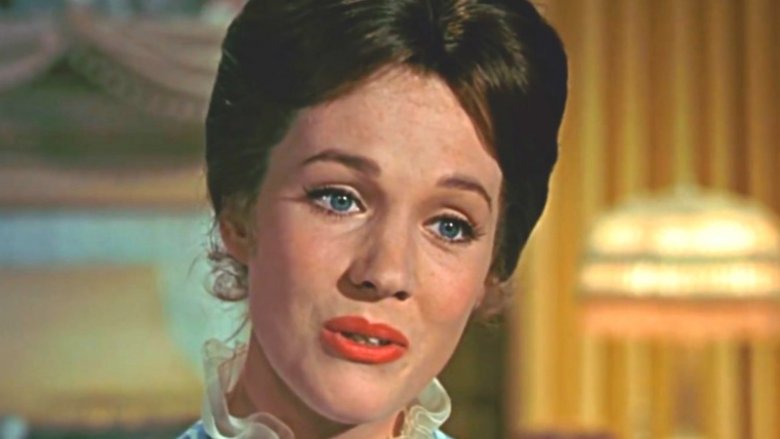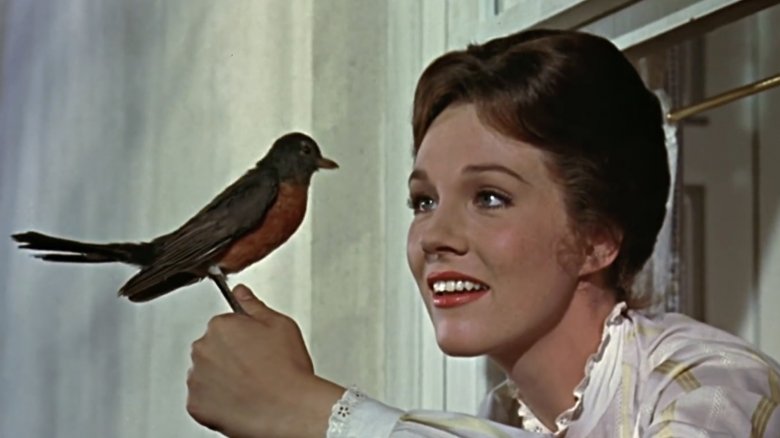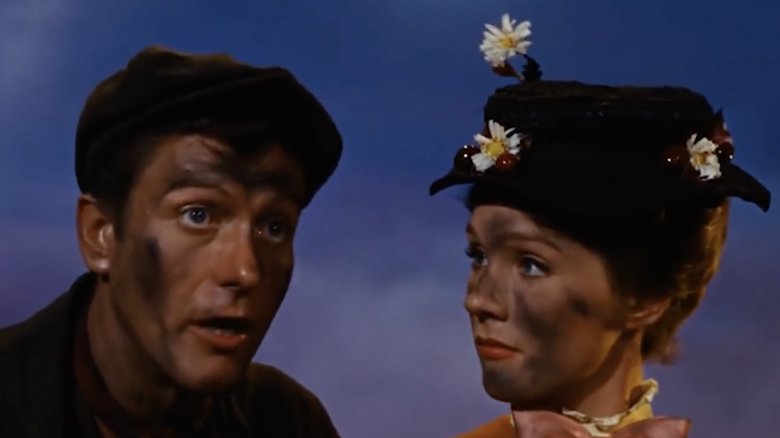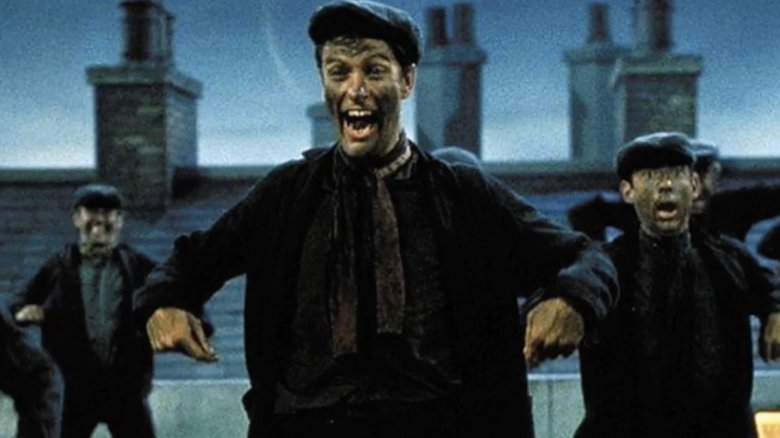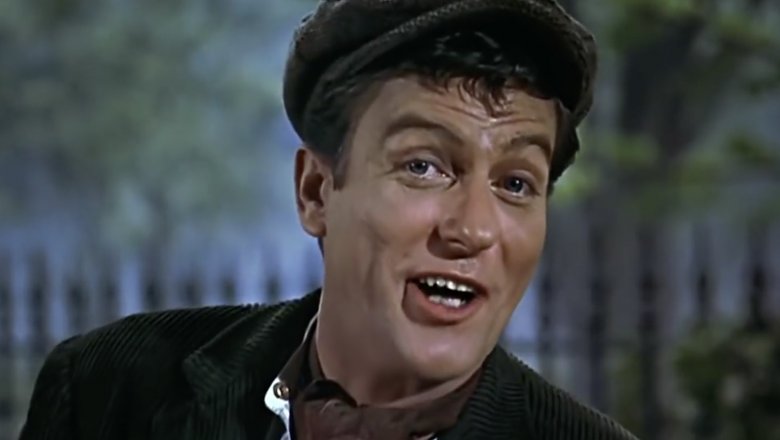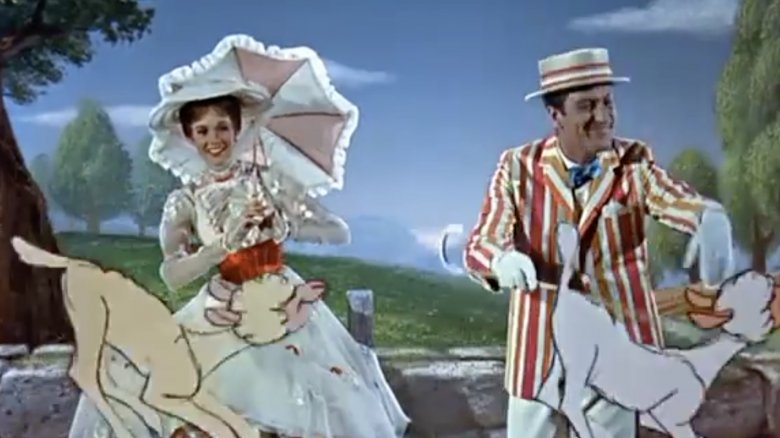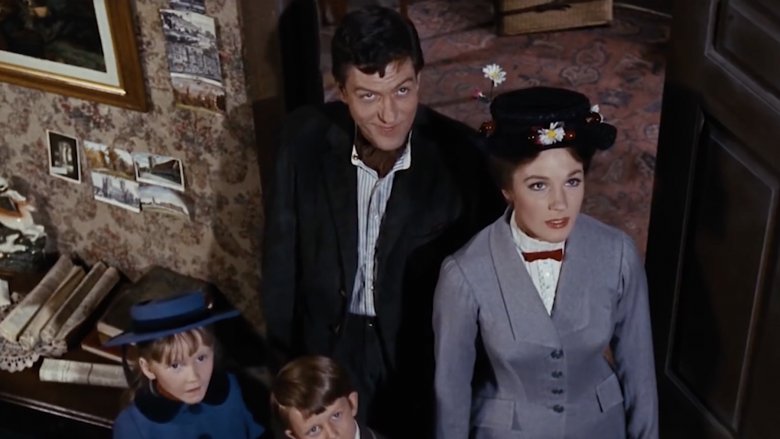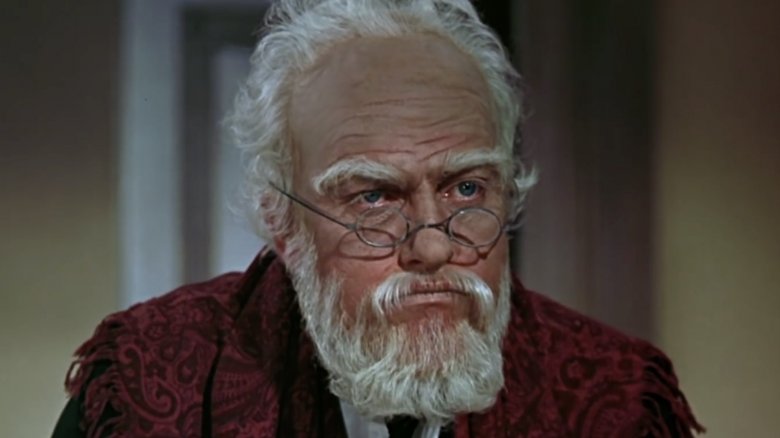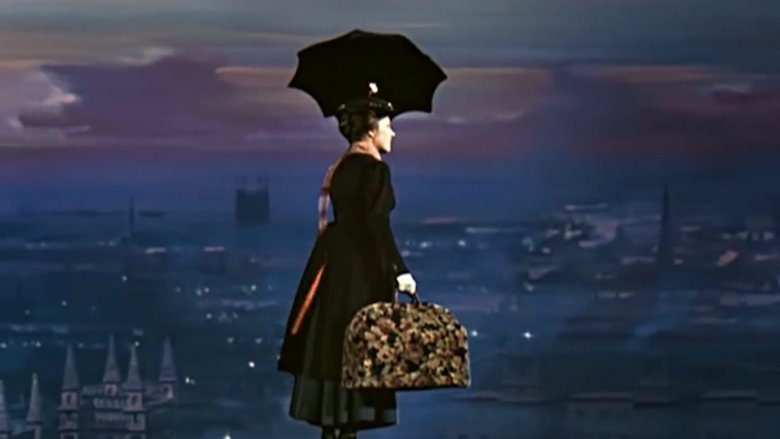Messed Up Things In Mary Poppins Everyone Just Ignored
Mary Poppins is one of the most beloved movies of all time. The 1964 Disney spectacular combines live action with animation and killer special effects (for the time) to bring to life early 20th-century London, where a mysteriously magical nanny makes the fractured and vaguely depressed Banks family whole again by caring for children Jane and Michael until their dad, a fussy bank employee, can get his act together.
Julie Andrews plays the "practically perfect in every way" title character, and she won an Academy Award for best actress for her trouble. Dick Van Dyke adopts an over-the-top Cockney accent to play Mary's "friend" Bert, and together they traipse about, singing classic songs like "A Spoonful of Sugar," "Jolly Holiday," and "Chim Chim Cheree." And while the sound of it may be something quite atrocious, the entire experience of watching Mary Poppins is, as Mary herself might say, "Supercalifragilisticexpialidocious."
Yes, it's all wholesome fun for the whole family; the movie literally ends with people positively giddy about flying their kites. And yet, there are a number of dark, creepy, and weird things about Mary Poppins that only older, or at least more cynical viewers, will pick up on.
Mary makes everyone she meets spellbound — literally
Isn't Mary Poppins such a fun person? What a breath of fresh air she is for the Bankses, a stuffy British family living in their stuffy British house. She's so whimsical with her firm-but-fair methods, as well as a song or an easy-to-remember rhyme for most any occasion. It's also such a neat trick how she can scoot up a bannister, somehow violating the laws of physics and human physiology. That is to say nothing of her seemingly bottomless bag that contains all her worldly possessions (and then some), and her umbrella that gives her the power of flight. Mary can even talk to birds!
This is not normal, nor is it "quirky behavior" or "fun babysitter" territory. Fun babysitters bring candy and Mad Libs — Mary Poppins is some kind of supernatural entity, probably a witch at the very least, and some kind of demigod at the most. Rather than engender feelings of distrust, terror, or rage in others — which, historically, has led to severe consequences for those who demonstrate witchy abilities — people just seem to largely be impressed or amused by Mary's antics.
Bert and Ms. Poppins, they've got a thing going on
So Mary literally floats into London when she somehow catches word that the Banks family needs a nanny to whip things into shape. Despite Mary being a mysterious figure from afar, Bert, a guy who spends all his time working and hanging out on the streets, already knows Mary ... and he's extremely fond of her, probably to his own detriment. He even senses when she's about to arrive and turn his world upside-down — and break his heart. Early in the film, he sings that the "wind's in the east" and "the mist's coming in," and that he has a "fear what's to happen all happened before."
Nevertheless, Mary briefly brightens Bert's existence almost as much as she brightens that of the Banks children — in one musical moment, Bert proclaims that "every day's a holiday with Mary," that she makes him feel "extraordinary," and that she's likely to make his "heart start beating like a big brass band." Those are not the things that happen to a person when an old friend rolls into town after even a long absence. This is to say Bert and Mary definitely have some kind of romantic history together, and it's maybe still ongoing. The way she comes into town, hangs out with a smitten Bert nearly constantly, and then leaves without saying goodbye implies that these two have a no-strings-attached, let's-not-put-a-label-on-this, same-time-next-year, friends-with-benefits arrangement.
Step in time to the black lung clinic
When an adult and/or at least mildly educated person thinks about Industrial Age London, they probably think of smog, filth, grime, altogether a city choked in lung-coating, cancer-causing pollution. They probably also think of the era's unique approach to labor, which was to put all the poor and their children to work to do all the nasty jobs and then pay them very little for it.
Perhaps there's no position more associated with late 19th- and early 20th-century London than the chimney sweep. So many furnaces burned across the city that a giant labor force was needed to regularly clean the chimneys that belched out black smoke. In Mary Poppins, we're privy to a group of chimney sweeps. Bert and his cohorts sing and dance to "Step in Time" with all their chimney-cleaning tools in tow. In reality, they were probably too busy pushing and pulling themselves in and out of chimneys and traveling down the cough-filled road to an early grave to jubilantly dance on rooftops.
He works hard for the money
Perhaps because it's low-status, thankless, filthy work, or perhaps because he spends too much of his working day stepping in time, sweeping chimneys doesn't seem to quite pay the bills for Bert. Bert holds down just so many jobs. To whit: He sells hot chestnuts on the street, he sells kites, he busks with his obnoxious one-man-band operation, he's a sidewalk chalk artist, and he's a chimney sweep. To younger viewers, most of those jobs seem like they'd be fun jobs — after all, he primarily plies his trade in the worlds of toys, art, and snacks.
An adult viewer, however, is more likely to emphasize for poor (literally) Bert. Why does he have to have so many jobs? Because the world is cruel, and London is expensive for a scrappy Cockney dude is why. He toils around the clock — he's literally always working, except during those few times when Mary pulls him away to keep her company on one her zany outings.
Psst, hey, wanna buy some 'jolly holiday'?
Mary Poppins is a very episodic film, and probably its most famous and memorable section is the one that's the most visually dazzling and technologically remarkable: when Mary and Bert, looking like the fanciest barbershop quartet singers of all time, take a live-action/animated excursion into one of Bert's drawings, where they sing "Jolly Holiday" with talking cartoon farm animals, dance with animated penguins, ride a grand carousel, and feast on treats at a candy-colored tea service.
It's a giant psychedelic adventure, a journey through realms, but mostly the realm of the inner workings of the mind. It could be that the "magic" Mary uses to whisk herself, Bert, and her charges to a brightly colored, anthropomorphic cartoon party land is some kind of hallucinogenic substance. This is even alluded to when Mary and the kids are back home, after the effects of the jolly holiday have worn off. Mary shoves some spoonfuls of medicine at Jane and Michael, and they fall fast asleep — they needed something to help them come down, it would seem.
Kids aren't supposed to talk to strangers
Parents of children viewing Mary Poppins just might be aghast at some of Mary Poppins' babysitting choices. We're not talking about the tough love, or even her insistence that they definitely consume some of her unidentified medicine without raising questions. Mary breaks two of the biggest rules to which an average, modern-day, teenage babysitter might be beholden: no boys and no leaving the house. Mary flaunts these rules in one fell swoop.
Mary hasn't been employed by the Bankses for long, and she's still virtually a stranger to the kids when she carts them along on a visit to "Uncle Albert" (Ed Wynn). Also present: Bert, Mary's chimney sweeping, street urchin sort-of-boyfriend. And unlike in that animated adventure, Mary takes them to a relatively sketchy place: the home of some guy they've never met, where the guy who has to be under the influence of something is laughing his head off and literally floating. Did Mary drag those kids to a drug den?
Friend to the birds, abandoned by society
Mary Poppins is about 90 percent fun, happy, and relentlessly optimistic. There's just one major sequence that feels incredibly out of place, on account of how it's extremely depressing. It's the part where Mary Poppins tells Jane and Michael, in song form, of a woman who sits outside St. Paul's Cathedral and tries to sell bags of breadcrumbs to pedestrians so they can feed the filthy pigeons that flock all around her. The price: cheap, just tuppence a bag.
While the scene may feel shoehorned in to include the beautiful and haunting ballad "Feed the Birds" by songwriters Richard and Robert Sherman, the woman selling breadcrumbs comes straight out of P.L. Travers' source material. Nevertheless, the song and the scene featuring the elderly woman (Jane Darwell) are haunting and unsettling. The Bird Woman, as she's called, is clearly homeless, and possibly mentally ill. In a more advanced society, perhaps she'd be getting some help and care, but that's a dream for the future. It's all just a very odd choice for a Disney movie.
You can't spell 'manslaughter' without 'laughter'
Throughout the film, opposite forces pull at Mr. Banks: the need to spend time with his family, and the need to spend time at the bank where he works and with which he is completely obsessed. Filmmakers illustrate how these two things are polar opposites by making the guy in charge of the bank as old as the Banks kids are young. And Mr. Dawes Sr. is incredibly old, outfitted with all the markers of age, including white hair and beard, little reading glasses, a cane to assist in his wobbly walking, and a constant wheeze emanating from his lungs. He's more of a parody of an old man, which more savvy viewers will realize is because an old man isn't portraying Mr. Dawes Sr. — it's Dick Van Dyke under all that makeup, fake hair, and props.
While placing Van Dyke in a dual role is a bit of innocuous, if self-indulgent trickery, Mr. Dawes' journey gets a little darker. He's the impetus for Mr. Banks deciding to be less of a workaholic and more of a jovial family man — a role for which he pays the price. Mr. Banks tells Mr. Dawes a joke, and the poor guy is so starved for humor that he laughs so hard he dies. Yeah — in this movie for children, Mr. Banks kills his boss.
Great job, you're fired
Bert isn't the only character in Mary Poppins facing some hard-to-swallow truths about the labor market. While he has to work endless jobs to get by, Mary just has the one, and it's presumably well-paying because the Banks family is clearly quite wealthy, what with the house in the nice part of town and the household staff. However, the entire endgame of her employment is to make herself obsolete and render her employment unnecessary. She comes to the Banks family to bring them closer together, and works hard at it throughout the film. She is ultimately successful: Mr. Banks starts the movie as a distant, grumpy, workaholic, and before long, he's a giggle machine flying kites with Jane and Michael. And that is when Mary Poppins chooses to take her leave, staying not a moment past her period of usefulness.
This is a dark and relatable concept for plenty of viewers. Mary's situation is like getting fired at any other job, except you have to train your replacement first. Or maybe it's like having your job eliminated by automation and you have to program the robots before they kick you to the curb.
